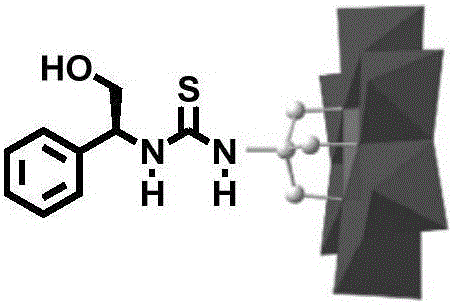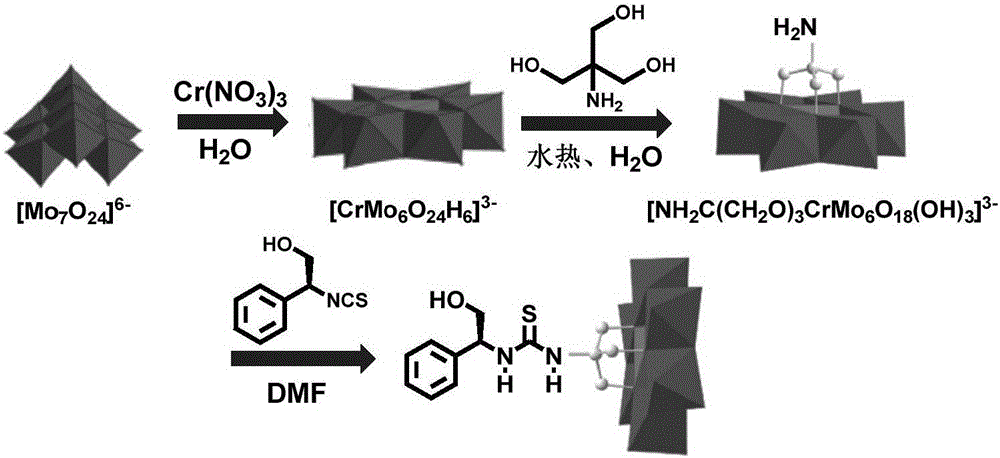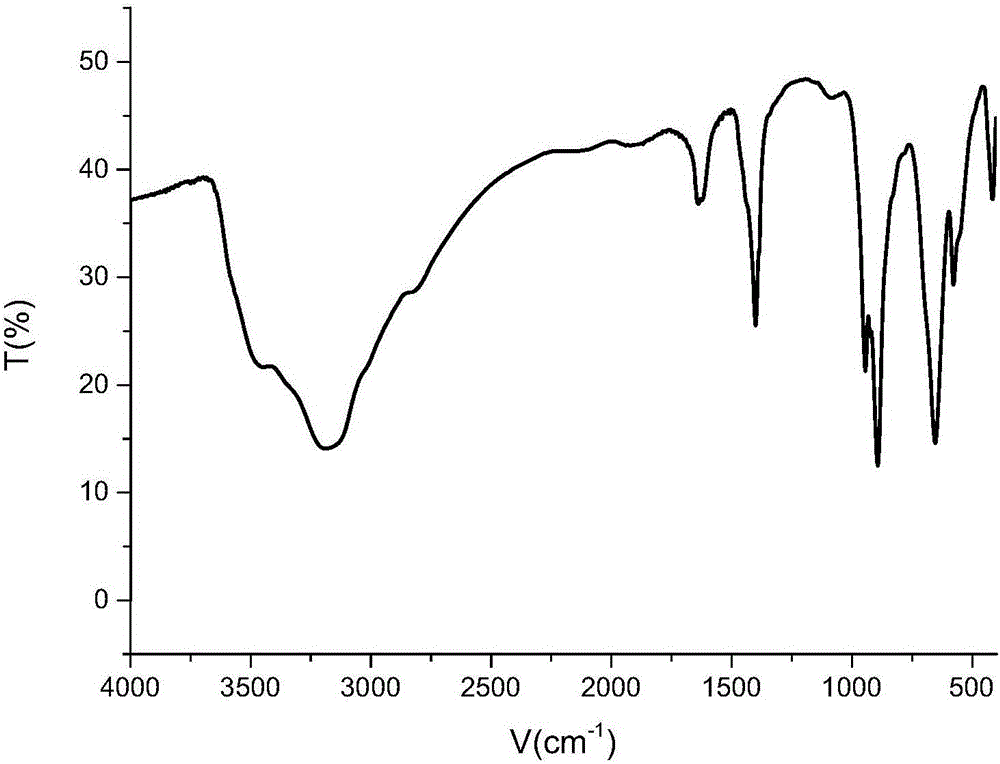(S)-1-(2-hydrox-1-phenethyl)thiourea modified Cr-Anderson heteropolyacid catalyst, and preparation method and application thereof
A technology of phenethyl and heteropoly acids, applied in the field of catalytic chemistry, can solve the problems of high dosage, low catalyst activity, difficult recycling and the like, and achieve the effects of high catalytic activity, high enantioselectivity and environmental friendliness
- Summary
- Abstract
- Description
- Claims
- Application Information
AI Technical Summary
Problems solved by technology
Method used
Image
Examples
Embodiment 1
[0036] Cr-Anderson type heteropolyacid precursor (NH 4 ) 3 [Cr(OH) 6 Mo 6 o 18 ] preparation
[0037] Take 7.41g (6mmol) of ammonium molybdate and add it to 20mL of deionized water, stir well to obtain a clear liquid, then add concentrated nitric acid dropwise, and adjust the pH of the system to 4~5. Heat to boiling, maintain strong stirring, and start to slowly add 1.66 g (7 mmol) chromium nitrate solid, stir until a large amount of pink solid is produced, stop stirring, and let stand for 15-30 minutes. Suction filtration to obtain 5.26 g of pink crystalline solid material with a yield of 82%.
[0038] Parent (NH 4 ) 3 [Cr(OH) 6 Mo 6 o 18 ] for the infrared spectrum figure 1 .
Embodiment 2
[0040] Preparation of (S)-1-(2-hydroxy-1-phenylethyl)isothiocyanate
[0041] Add L-phenylglycinol (0.6859g, 5mmol) into a dry reaction vessel, dissolve it with 20mL of ethanol, then slowly add CS 2 (0.1142g, 15mmol) and triethylamine (0.506mg, 5mmol), after stirring the reaction at room temperature for 1h, then adding di-tert-butyl dicarbonate (Boc 2 O) (1.091mg, 5mmol) and 4-dimethylaminopyridine (DMAP) (18mg, 0.15mmol), after stirring and reacting at room temperature for 2h (gas is generated during the stirring process, attention should be paid to degassing and decompression), which can be obtained 0.7547 g (S)-1-(2-hydroxy-1-phenethyl)isothiocyanate.
[0042] The NMR spectrum of (S)-1-(2-hydroxy-1-phenylethyl)isothiocyanate is as follows Figure 4 As shown, the specific data are as follows:
[0043] 1 H NMR (501MHz, CDCl 3 ):δ7.45-7.29(m,5H),5.06(dt,J=52.6,9.1Hz,2H),4.49(dd,J=8.8,7.0Hz,1H),1.38-1.15(m,1H).
Embodiment 3
[0045] Preparation of Cr-Anderson Polyoxometalates Modified with One-side Amino Group
[0046] The above-obtained Anderson matrix (NH 4 ) 3 [Cr(OH) 6 Mo 6 o 18 ] 1.071g (1mmol) was dissolved in 10mL deionized water to obtain a light red clear liquid, and then 0.402g (3mmol) of trishydroxyaminomethane was slowly added. Then add the above system into the hydrothermal kettle and heat it to 140°C in the hydrothermal kettle. After 24 hours of reaction, add 4.83g of tetrabutylammonium bromide to the solution dissolved as above at 85°C, resulting in a large amount of pink The precipitate is the crude product, and the red liquid can be obtained by suction filtration, and the crystal is obtained after standing, which is the Cr-Anderson type polyacid [TBA] modified by organic one-sided amino group 3 {[CH 2 NH 2 C(CH 2 O) 3 ]CrMo 6 o 18 (OH) 3}.
[0047] The infrared spectrum of the Cr-Anderson type polyoxometalate modified with one side amino group is as follows: Figure 5...
PUM
 Login to View More
Login to View More Abstract
Description
Claims
Application Information
 Login to View More
Login to View More - R&D
- Intellectual Property
- Life Sciences
- Materials
- Tech Scout
- Unparalleled Data Quality
- Higher Quality Content
- 60% Fewer Hallucinations
Browse by: Latest US Patents, China's latest patents, Technical Efficacy Thesaurus, Application Domain, Technology Topic, Popular Technical Reports.
© 2025 PatSnap. All rights reserved.Legal|Privacy policy|Modern Slavery Act Transparency Statement|Sitemap|About US| Contact US: help@patsnap.com



